Deck 3: Polynomial and Rational Functions
سؤال
سؤال
سؤال
سؤال
سؤال
سؤال
سؤال
سؤال
سؤال
سؤال
سؤال
سؤال
سؤال
سؤال
سؤال
سؤال
سؤال
سؤال
سؤال
سؤال
سؤال
سؤال
سؤال
سؤال
سؤال
سؤال
سؤال
سؤال
سؤال
سؤال
سؤال
سؤال
سؤال
سؤال
سؤال
سؤال
سؤال
سؤال
سؤال
سؤال
سؤال
سؤال
سؤال
سؤال
سؤال
سؤال
سؤال
سؤال
سؤال
سؤال
سؤال
سؤال
سؤال
سؤال
سؤال
سؤال
سؤال
سؤال
سؤال
سؤال
سؤال
سؤال
سؤال
سؤال
سؤال
سؤال
سؤال
سؤال
سؤال
سؤال
سؤال
سؤال
سؤال
سؤال
سؤال
سؤال
سؤال
سؤال
سؤال
سؤال

فتح الحزمة
قم بالتسجيل لفتح البطاقات في هذه المجموعة!
Unlock Deck
Unlock Deck
1/122
العب
ملء الشاشة (f)
Deck 3: Polynomial and Rational Functions
1
Complete the square to write the function in shifted form. f(x) = x2 + 7x + 1
A) f(x) =
B) f(x) =
C) f(x) =
D) f(x) =
A) f(x) =

B) f(x) =

C) f(x) =

D) f(x) =

f(x) = 

2
Use the following to answer questions :
An automobile manufacturer can produce up to 300 cars per day. The profit made from the sale of these vehicles can be modeled by the function , where P(x) is the profit in dollars and x is the number of automobiles made and sold.
, where P(x) is the profit in dollars and x is the number of automobiles made and sold.
Find the y-intercept and explain what it means in this context.
An automobile manufacturer can produce up to 300 cars per day. The profit made from the sale of these vehicles can be modeled by the function
 , where P(x) is the profit in dollars and x is the number of automobiles made and sold.
, where P(x) is the profit in dollars and x is the number of automobiles made and sold.Find the y-intercept and explain what it means in this context.
(0, -22,000); when no cars are produced, there is a loss of $22,000
3
Use synthetic division and the remainder theorem to evaluate P(-3) if P(x) = 2x3 - 3x2 + 5x - 13.
A) -110
B) -109
C) -108
D) -107
A) -110
B) -109
C) -108
D) -107
-109
4
Use the following to answer questions :
An automobile manufacturer can produce up to 300 cars per day. The profit made from the sale of these vehicles can be modeled by the function , where P(x) is the profit in dollars and x is the number of automobiles made and sold.
, where P(x) is the profit in dollars and x is the number of automobiles made and sold.
What is the maximum profit?
A) $98,000
B) $99,000
C) $100,000
D) $101,000
An automobile manufacturer can produce up to 300 cars per day. The profit made from the sale of these vehicles can be modeled by the function
 , where P(x) is the profit in dollars and x is the number of automobiles made and sold.
, where P(x) is the profit in dollars and x is the number of automobiles made and sold.What is the maximum profit?
A) $98,000
B) $99,000
C) $100,000
D) $101,000

فتح الحزمة
افتح القفل للوصول البطاقات البالغ عددها 122 في هذه المجموعة.
فتح الحزمة
k this deck
5
Use synthetic division and the remainder theorem to show that x = -2 is a zero of P(x) = x3 - 4x2 - 4x + 16.

فتح الحزمة
افتح القفل للوصول البطاقات البالغ عددها 122 في هذه المجموعة.
فتح الحزمة
k this deck
6
Find the vertex.
f(x) = x2 + 10x - 8
f(x) = x2 + 10x - 8

فتح الحزمة
افتح القفل للوصول البطاقات البالغ عددها 122 في هذه المجموعة.
فتح الحزمة
k this deck
7
Use the following to answer questions :
An automobile manufacturer can produce up to 300 cars per day. The profit made from the sale of these vehicles can be modeled by the function , where P(x) is the profit in dollars and x is the number of automobiles made and sold.
, where P(x) is the profit in dollars and x is the number of automobiles made and sold.
How many cars should be made and sold to maximize profit?
A) 25
B) 75
C) 150
D) 1500
An automobile manufacturer can produce up to 300 cars per day. The profit made from the sale of these vehicles can be modeled by the function
 , where P(x) is the profit in dollars and x is the number of automobiles made and sold.
, where P(x) is the profit in dollars and x is the number of automobiles made and sold.How many cars should be made and sold to maximize profit?
A) 25
B) 75
C) 150
D) 1500

فتح الحزمة
افتح القفل للوصول البطاقات البالغ عددها 122 في هذه المجموعة.
فتح الحزمة
k this deck
8
Graph the function using end behavior, intercepts and by completing the square to write the function in shifted form. Clearly state the transformations used to obtain the graph, and label the vertex and all intercepts (if they exist). Use the quadratic formula to find the x-intercepts.
f(x) = 2x2 - 9x + 4
f(x) = 2x2 - 9x + 4

فتح الحزمة
افتح القفل للوصول البطاقات البالغ عددها 122 في هذه المجموعة.
فتح الحزمة
k this deck
9
Find the intercepts. Round to the nearest tenth if necessary.
f(x) = 3x2 + 8x - 6
f(x) = 3x2 + 8x - 6

فتح الحزمة
افتح القفل للوصول البطاقات البالغ عددها 122 في هذه المجموعة.
فتح الحزمة
k this deck
10
Find the intercepts.
f(x) = x2 - 10x + 24
f(x) = x2 - 10x + 24

فتح الحزمة
افتح القفل للوصول البطاقات البالغ عددها 122 في هذه المجموعة.
فتح الحزمة
k this deck
11
Use the vertex/intercept formula,  , to find zeroes, real or complex of the formula. f(x) = 3(x + 1)2 - 2
, to find zeroes, real or complex of the formula. f(x) = 3(x + 1)2 - 2
A)
B)
C)
D)
 , to find zeroes, real or complex of the formula. f(x) = 3(x + 1)2 - 2
, to find zeroes, real or complex of the formula. f(x) = 3(x + 1)2 - 2A)

B)

C)

D)


فتح الحزمة
افتح القفل للوصول البطاقات البالغ عددها 122 في هذه المجموعة.
فتح الحزمة
k this deck
12
Graph the function using end behavior, intercepts and by completing the square to write the function in shifted form. Clearly state the transformations used to obtain the graph, and label the vertex and all intercepts (if they exist). Use the quadratic formula to find the x-intercepts. f(x) = 3x2 + 5x + 1
A) left 1, down 2, stretched vertically
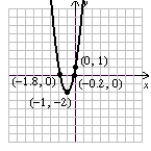
B) right 1, down 2, stretched vertically
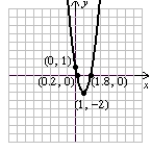
C) left .8, down 1.1, stretched vertically
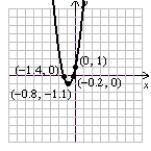
D) right .8, down 1.1, stretched vertically
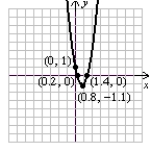
A) left 1, down 2, stretched vertically

B) right 1, down 2, stretched vertically

C) left .8, down 1.1, stretched vertically

D) right .8, down 1.1, stretched vertically


فتح الحزمة
افتح القفل للوصول البطاقات البالغ عددها 122 في هذه المجموعة.
فتح الحزمة
k this deck
13
Complete the square to write the function in shifted form.
f(x) = x2 + 6x + 1
f(x) = x2 + 6x + 1

فتح الحزمة
افتح القفل للوصول البطاقات البالغ عددها 122 في هذه المجموعة.
فتح الحزمة
k this deck
14
Determine the equation of the function shown. 
A) f(x) = -x2 + 1
B) f(x) = -x2 - 1
C) f(x) = -(x + 1)2
D) f(x) = -(x - 1)2

A) f(x) = -x2 + 1
B) f(x) = -x2 - 1
C) f(x) = -(x + 1)2
D) f(x) = -(x - 1)2

فتح الحزمة
افتح القفل للوصول البطاقات البالغ عددها 122 في هذه المجموعة.
فتح الحزمة
k this deck
15
Graph the function using end behavior, intercepts and by completing the square to write the function in shifted form. Clearly state the transformations used to obtain the graph, and label the vertex and all intercepts (if they exist). Use the quadratic formula to find the x-intercepts.
f(x) = -x2 + 4x - 3
f(x) = -x2 + 4x - 3

فتح الحزمة
افتح القفل للوصول البطاقات البالغ عددها 122 في هذه المجموعة.
فتح الحزمة
k this deck
16
Graph the function using the concavity, y-intercept, x-intercept(s), vertex, and symmetry. f(x) = 
A)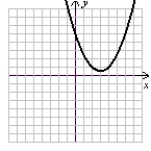
(Gridlines are spaced one unit apart.)
B)
(Gridlines are spaced one unit apart.)
C)
(Gridlines are spaced one unit apart.)
D)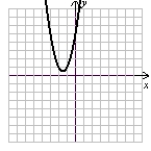
(Gridlines are spaced one unit apart.)

A)

(Gridlines are spaced one unit apart.)
B)

(Gridlines are spaced one unit apart.)
C)

(Gridlines are spaced one unit apart.)
D)

(Gridlines are spaced one unit apart.)

فتح الحزمة
افتح القفل للوصول البطاقات البالغ عددها 122 في هذه المجموعة.
فتح الحزمة
k this deck
17
Use synthetic division and the remainder theorem to evaluate P(4) if P(x) = x3 - 5x2 - 4x + 20. Verify using a second method.

فتح الحزمة
افتح القفل للوصول البطاقات البالغ عددها 122 في هذه المجموعة.
فتح الحزمة
k this deck
18
Use the following to answer questions :
An automobile manufacturer can produce up to 300 cars per day. The profit made from the sale of these vehicles can be modeled by the function , where P(x) is the profit in dollars and x is the number of automobiles made and sold.
, where P(x) is the profit in dollars and x is the number of automobiles made and sold.
Find the x-intercepts and explain what they mean in this context.
An automobile manufacturer can produce up to 300 cars per day. The profit made from the sale of these vehicles can be modeled by the function
 , where P(x) is the profit in dollars and x is the number of automobiles made and sold.
, where P(x) is the profit in dollars and x is the number of automobiles made and sold.Find the x-intercepts and explain what they mean in this context.

فتح الحزمة
افتح القفل للوصول البطاقات البالغ عددها 122 في هذه المجموعة.
فتح الحزمة
k this deck
19
Graph the function using the end behavior, y-intercept, x-intercept(s), vertex, and symmetry. Label the vertex and all intercepts (if they exist). (Round to tenths as necessary).
f(x) = -x2 + 2x + 5
f(x) = -x2 + 2x + 5

فتح الحزمة
افتح القفل للوصول البطاقات البالغ عددها 122 في هذه المجموعة.
فتح الحزمة
k this deck
20
Graph the function using end behavior, intercepts and by completing the square to write the function in shifted form. Clearly state the transformations used to obtain the graph, and label the vertex and all intercepts (if they exist). Use the quadratic formula to find the x-intercepts.
f(x) = 2x2 + 9x + 4
f(x) = 2x2 + 9x + 4

فتح الحزمة
افتح القفل للوصول البطاقات البالغ عددها 122 في هذه المجموعة.
فتح الحزمة
k this deck
21
A polynomial P of degree 3 with integer coefficients has zeroes x = 5,  , and
, and  . Use the factor theorem to write the polynomial in factored form and standard form.
. Use the factor theorem to write the polynomial in factored form and standard form.
 , and
, and  . Use the factor theorem to write the polynomial in factored form and standard form.
. Use the factor theorem to write the polynomial in factored form and standard form.
فتح الحزمة
افتح القفل للوصول البطاقات البالغ عددها 122 في هذه المجموعة.
فتح الحزمة
k this deck
22
Use the factor theorem to find the polynomial of degree 4 having zeroes  ,
,  , x = 3 + i, x = 3 - i. Assume a lead coefficient of 1.
, x = 3 + i, x = 3 - i. Assume a lead coefficient of 1.
 ,
,  , x = 3 + i, x = 3 - i. Assume a lead coefficient of 1.
, x = 3 + i, x = 3 - i. Assume a lead coefficient of 1.
فتح الحزمة
افتح القفل للوصول البطاقات البالغ عددها 122 في هذه المجموعة.
فتح الحزمة
k this deck
23
Find a cubic polynomial with real coefficients having roots x = -2 and x = 1 + 4i. Assume a lead coefficient of 1.
A) P(x) = x3 + 13x + 34
B) P(x) = x3 + 13x - 34
C) P(x) = x3 + 4x2 + 21x + 34
D) P(x) = x3 - 4x2 + 21x - 34
A) P(x) = x3 + 13x + 34
B) P(x) = x3 + 13x - 34
C) P(x) = x3 + 4x2 + 21x + 34
D) P(x) = x3 - 4x2 + 21x - 34

فتح الحزمة
افتح القفل للوصول البطاقات البالغ عددها 122 في هذه المجموعة.
فتح الحزمة
k this deck
24
Use the rational roots theorem to write the function in factored form and find all zeroes. Note a = 1. p(x) = x4 + 6x3 - 13x2 - 66x + 72
A) p(x) = (x - 1)(x - 3)(x + 4)(x + 6); zeroes: 1, 3, -4, -6
B) p(x) = (x + 1)(x + 3)(x - 4)(x - 6); zeroes: -1, -3, 4, 6
C) p(x) = (x - 1)(x + 3)(x - 4)(x + 6); zeroes: 1, -3, 4, -6
D) p(x) = (x + 1)(x - 3)(x + 4)(x - 6); zeroes: -1, 3, -4, 6
A) p(x) = (x - 1)(x - 3)(x + 4)(x + 6); zeroes: 1, 3, -4, -6
B) p(x) = (x + 1)(x + 3)(x - 4)(x - 6); zeroes: -1, -3, 4, 6
C) p(x) = (x - 1)(x + 3)(x - 4)(x + 6); zeroes: 1, -3, 4, -6
D) p(x) = (x + 1)(x - 3)(x + 4)(x - 6); zeroes: -1, 3, -4, 6

فتح الحزمة
افتح القفل للوصول البطاقات البالغ عددها 122 في هذه المجموعة.
فتح الحزمة
k this deck
25
List all possible rational roots for the polynomial but do not solve.
f(x) = 21x3 - 5x2 + x - 175
f(x) = 21x3 - 5x2 + x - 175

فتح الحزمة
افتح القفل للوصول البطاقات البالغ عددها 122 في هذه المجموعة.
فتح الحزمة
k this deck
26
Use the following to answer questions :
p(x) = x4 - 5x3 + 5x2 + 5x - 6
Use the rational roots theorem to list all possible rational roots.
A)
B)
C)
D)
p(x) = x4 - 5x3 + 5x2 + 5x - 6
Use the rational roots theorem to list all possible rational roots.
A)

B)

C)

D)


فتح الحزمة
افتح القفل للوصول البطاقات البالغ عددها 122 في هذه المجموعة.
فتح الحزمة
k this deck
27
Use the rational roots theorem to write the function in factored form and find all zeroes. Note a = 1.
p(x) = x3 + 4x2 - 9x - 36
p(x) = x3 + 4x2 - 9x - 36

فتح الحزمة
افتح القفل للوصول البطاقات البالغ عددها 122 في هذه المجموعة.
فتح الحزمة
k this deck
28
Find a quartic polynomial (degree 4) with real coefficients having roots x = -5i and x =  i. Assume a lead coefficient of 1.
i. Assume a lead coefficient of 1.
A) P(x) = x4 + 32x3 + 25x2 + 7x + 175
B) P(x) = x4 + 25x3 + 32x2 + 7x + 175
C) P(x) = x4 + 32x2 + 175
D) P(x) = x4 + 25x2 + 175
 i. Assume a lead coefficient of 1.
i. Assume a lead coefficient of 1.A) P(x) = x4 + 32x3 + 25x2 + 7x + 175
B) P(x) = x4 + 25x3 + 32x2 + 7x + 175
C) P(x) = x4 + 32x2 + 175
D) P(x) = x4 + 25x2 + 175

فتح الحزمة
افتح القفل للوصول البطاقات البالغ عددها 122 في هذه المجموعة.
فتح الحزمة
k this deck
29
Use synthetic division and the remainder theorem to show x = 1 - 3i is a zero of P(x) = -x3 - x2 - 4x - 30.

فتح الحزمة
افتح القفل للوصول البطاقات البالغ عددها 122 في هذه المجموعة.
فتح الحزمة
k this deck
30
Find a polynomial P with real coefficients having degree 5, only one real, rational root, and zeroes x = 2 and x = 1 + 5i. Assume a lead coefficient of 1. Leave your answer in factored form.

فتح الحزمة
افتح القفل للوصول البطاقات البالغ عددها 122 في هذه المجموعة.
فتح الحزمة
k this deck
31
Find the zeroes of the polynomial using any combination of the rational roots theorem, synthetic division, testing for 1 and -1, and/or the remainder and factor theorems.
p(x) = 4x4 - 3x3 - 30x2 - x + 30
p(x) = 4x4 - 3x3 - 30x2 - x + 30

فتح الحزمة
افتح القفل للوصول البطاقات البالغ عددها 122 في هذه المجموعة.
فتح الحزمة
k this deck
32
Find all rational zeroes of the function given and use them to write the function in factored form. Use the factored form to state all zeroes of the function. Begin by applying the tests for 1 and -1. p(x) = 4x4 + x3 + 33x2 +9x - 27
A) p(x) = (x - 1)(4x - 3)(x - 3i)(x + 3i); zeroes: 1, , 3i, -3i
, 3i, -3i
B) p(x) = (x - 1)(4x + 3)(x - 3i)(x + 3i); zeroes: 1, - , 3i, -3i
, 3i, -3i
C) p(x) = (x + 1)(4x - 3)(x - 3i)(x + 3i); zeroes: -1, , 3i, -3i
, 3i, -3i
D) p(x) = (x + 1)(4x + 3)(x - 3i)(x + 3i); zeroes: -1, - , 3i, -3i
, 3i, -3i
A) p(x) = (x - 1)(4x - 3)(x - 3i)(x + 3i); zeroes: 1,
 , 3i, -3i
, 3i, -3iB) p(x) = (x - 1)(4x + 3)(x - 3i)(x + 3i); zeroes: 1, -
 , 3i, -3i
, 3i, -3iC) p(x) = (x + 1)(4x - 3)(x - 3i)(x + 3i); zeroes: -1,
 , 3i, -3i
, 3i, -3iD) p(x) = (x + 1)(4x + 3)(x - 3i)(x + 3i); zeroes: -1, -
 , 3i, -3i
, 3i, -3i
فتح الحزمة
افتح القفل للوصول البطاقات البالغ عددها 122 في هذه المجموعة.
فتح الحزمة
k this deck
33
Find a cubic polynomial with real coefficients having roots x = -3 and x = -i. Assume a lead coefficient of 1.

فتح الحزمة
افتح القفل للوصول البطاقات البالغ عددها 122 في هذه المجموعة.
فتح الحزمة
k this deck
34
Use the remainder theorem to show x = 2i is a zero of P(x) = x3 + 2x2 + 4x + 8.

فتح الحزمة
افتح القفل للوصول البطاقات البالغ عددها 122 في هذه المجموعة.
فتح الحزمة
k this deck
35
Factor completely. Then state the multiplicity of the roots and the degree of P.
P(x) = x3 - 2x2 - 15x + 36.
P(x) = x3 - 2x2 - 15x + 36.

فتح الحزمة
افتح القفل للوصول البطاقات البالغ عددها 122 في هذه المجموعة.
فتح الحزمة
k this deck
36
A polynomial P of degree 3 with integer coefficients has zeroes x = 3, x = -9, and x = 1. Use the factor theorem to write the polynomial in factored form.
A) P(x) = (x + 3)(x - 9)(x + 1)
B) P(x) = (x - 3)(x + 9)(x - 1)
C) P(x) = (3x + 1)(-9x + 1)(x + 1)
D) P(x) = (-3x + 1)(9x + 1)(-x + 1)
A) P(x) = (x + 3)(x - 9)(x + 1)
B) P(x) = (x - 3)(x + 9)(x - 1)
C) P(x) = (3x + 1)(-9x + 1)(x + 1)
D) P(x) = (-3x + 1)(9x + 1)(-x + 1)

فتح الحزمة
افتح القفل للوصول البطاقات البالغ عددها 122 في هذه المجموعة.
فتح الحزمة
k this deck
37
Find a quartic polynomial (degree 4) with real coefficients having roots x =  and x = 1 +
and x = 1 +  i. Assume a lead coefficient of 1.
i. Assume a lead coefficient of 1.
 and x = 1 +
and x = 1 +  i. Assume a lead coefficient of 1.
i. Assume a lead coefficient of 1.
فتح الحزمة
افتح القفل للوصول البطاقات البالغ عددها 122 في هذه المجموعة.
فتح الحزمة
k this deck
38
Find the zeroes of the polynomial using any combination of the rational roots theorem, synthetic division, testing for 1 and -1, and/or the remainder and factor theorems. p(x) = x4 + 3x3 + 3x2 - 17x - 18
A) -1, 2,
B) 1, -2,
C) -1, 2,
D) 1, -2,
A) -1, 2,

B) 1, -2,

C) -1, 2,

D) 1, -2,


فتح الحزمة
افتح القفل للوصول البطاقات البالغ عددها 122 في هذه المجموعة.
فتح الحزمة
k this deck
39
Use the factor theorem to find the polynomial of degree 3 having zeroes x = 1, x = 1 - 4i, and x = 1 + 4i. Assume a lead coefficient of 1.
A) P(x) = x3 - 3x2 + 20x - 16
B) P(x) = x3 - 3x2 + 20x - 17
C) P(x) = x3 - 3x2 + 19x - 16
D) P(x) = x3 - 3x2 + 19x - 17
A) P(x) = x3 - 3x2 + 20x - 16
B) P(x) = x3 - 3x2 + 20x - 17
C) P(x) = x3 - 3x2 + 19x - 16
D) P(x) = x3 - 3x2 + 19x - 17

فتح الحزمة
افتح القفل للوصول البطاقات البالغ عددها 122 في هذه المجموعة.
فتح الحزمة
k this deck
40
Use the intermediate value theorem to verify that the polynomial f(x) = -2x3 - 4x2 + 3x - 4 has at least one zero "ci" in the interval [-3, -1]. Do not find the zeroes.
A) Yes
B) No
A) Yes
B) No

فتح الحزمة
افتح القفل للوصول البطاقات البالغ عددها 122 في هذه المجموعة.
فتح الحزمة
k this deck
41
Find all zeroes (real and complex) of the polynomial.
p(x) = 4x3 - 5x2 - 23x + 6
p(x) = 4x3 - 5x2 - 23x + 6

فتح الحزمة
افتح القفل للوصول البطاقات البالغ عددها 122 في هذه المجموعة.
فتح الحزمة
k this deck
42
Gather information on the polynomial using the rational roots theorem, testing for 1 and -1, Descartes's rule of signs, and the upper and lower bounds property. Respond explicitly to each.
p(x) = x4 - 3x3 + 9x - 27
p(x) = x4 - 3x3 + 9x - 27

فتح الحزمة
افتح القفل للوصول البطاقات البالغ عددها 122 في هذه المجموعة.
فتح الحزمة
k this deck
43
State the degree and end behavior of the function. f(x) = (x - 1)6(x + 3)(x - 3)3
A) degree 9, up/up
B) degree 9, down/up
C) degree 10, up/up
D) degree 10, down/up
A) degree 9, up/up
B) degree 9, down/up
C) degree 10, up/up
D) degree 10, down/up

فتح الحزمة
افتح القفل للوصول البطاقات البالغ عددها 122 في هذه المجموعة.
فتح الحزمة
k this deck
44
State the end behavior and y-intercept of the function. Do not graph.
f(x) = x5 + 5x4 - 5x2 - 3x + 5
f(x) = x5 + 5x4 - 5x2 - 3x + 5

فتح الحزمة
افتح القفل للوصول البطاقات البالغ عددها 122 في هذه المجموعة.
فتح الحزمة
k this deck
45
Use the following to answer questions :  (Gridlines are spaced one unit apart.)
(Gridlines are spaced one unit apart.)
Find the minimum possible degree of the function and write it in factored form. Assume all zeroes are real.
A) f(x) = -(x + 1)(x - 2)
B) f(x) = -(x + 1)2(x - 2)
C) f(x) = (x + 1)(x - 2)2
D) f(x) = (x + 1)2(x - 2)
 (Gridlines are spaced one unit apart.)
(Gridlines are spaced one unit apart.)Find the minimum possible degree of the function and write it in factored form. Assume all zeroes are real.
A) f(x) = -(x + 1)(x - 2)
B) f(x) = -(x + 1)2(x - 2)
C) f(x) = (x + 1)(x - 2)2
D) f(x) = (x + 1)2(x - 2)

فتح الحزمة
افتح القفل للوصول البطاقات البالغ عددها 122 في هذه المجموعة.
فتح الحزمة
k this deck
46
Use the following to answer questions :  (Gridlines are spaced one unit apart.)
(Gridlines are spaced one unit apart.)
State whether the degree of the function is even or odd.
A) even
B) odd
 (Gridlines are spaced one unit apart.)
(Gridlines are spaced one unit apart.)State whether the degree of the function is even or odd.
A) even
B) odd

فتح الحزمة
افتح القفل للوصول البطاقات البالغ عددها 122 في هذه المجموعة.
فتح الحزمة
k this deck
47
Use the following to answer questions :  (Gridlines are spaced one unit apart.)
(Gridlines are spaced one unit apart.)
Use the graph to estimate the zeroes of the function, then state whether their multiplicity is even or odd.
A) -1, even; 2 odd
B) -1, odd; 2 even
C) -1, even; 2 even
D) -1, odd; 2 odd
 (Gridlines are spaced one unit apart.)
(Gridlines are spaced one unit apart.)Use the graph to estimate the zeroes of the function, then state whether their multiplicity is even or odd.
A) -1, even; 2 odd
B) -1, odd; 2 even
C) -1, even; 2 even
D) -1, odd; 2 odd

فتح الحزمة
افتح القفل للوصول البطاقات البالغ عددها 122 في هذه المجموعة.
فتح الحزمة
k this deck
48
Use the Guidelines for Graphing Polynomial Functions to graph the polynomial.
f(x) = x3 - 3x - 2
f(x) = x3 - 3x - 2

فتح الحزمة
افتح القفل للوصول البطاقات البالغ عددها 122 في هذه المجموعة.
فتح الحزمة
k this deck
49
For the complex polynomial below, one of its zeroes is z = 5i. Use the given zero to help find all zeroes of the polynomial, then write the polynomial in completely factored form. Hint: synthetic division and the quadratic formula can be applied to all polynomials, even those with complex coefficients.
C(z) = z3 + (1 - 5i)z2 + (-6 - 5i)z + 30i.
C(z) = z3 + (1 - 5i)z2 + (-6 - 5i)z + 30i.

فتح الحزمة
افتح القفل للوصول البطاقات البالغ عددها 122 في هذه المجموعة.
فتح الحزمة
k this deck
50
State the degree, end behavior, and y-intercept of the function.
f(x) = -(x - 5)(x - 1)8(x - 2)2
f(x) = -(x - 5)(x - 1)8(x - 2)2

فتح الحزمة
افتح القفل للوصول البطاقات البالغ عددها 122 في هذه المجموعة.
فتح الحزمة
k this deck
51
State the end behavior of the function. f(x) = 5x4 + 2x3 - 5x2 - 5x - 3
A) down/up
B) up/down
C) down/down
D) up/up
A) down/up
B) up/down
C) down/down
D) up/up

فتح الحزمة
افتح القفل للوصول البطاقات البالغ عددها 122 في هذه المجموعة.
فتح الحزمة
k this deck
52
Use the following to answer questions :
p(x) = x4 - 5x3 + 5x2 + 5x - 6
Use the information gathered, testing for 1 and -1, synthetic division, and the factor theorem to factor p completely.
A) p(x) = (x + 1)(x - 1)(x + 2)(x + 3)
B) p(x) = (x + 1)(x - 1)(x - 2)(x + 3)
C) p(x) = (x + 1)(x - 1)(x + 2)(x - 3)
D) p(x) = (x + 1)(x - 1)(x - 2)(x - 3)
p(x) = x4 - 5x3 + 5x2 + 5x - 6
Use the information gathered, testing for 1 and -1, synthetic division, and the factor theorem to factor p completely.
A) p(x) = (x + 1)(x - 1)(x + 2)(x + 3)
B) p(x) = (x + 1)(x - 1)(x - 2)(x + 3)
C) p(x) = (x + 1)(x - 1)(x + 2)(x - 3)
D) p(x) = (x + 1)(x - 1)(x - 2)(x - 3)

فتح الحزمة
افتح القفل للوصول البطاقات البالغ عددها 122 في هذه المجموعة.
فتح الحزمة
k this deck
53
Find all zeroes (real and complex) of the polynomial.
p(x) = 6x3 + 29x2 - 149x + 24
p(x) = 6x3 + 29x2 - 149x + 24

فتح الحزمة
افتح القفل للوصول البطاقات البالغ عددها 122 في هذه المجموعة.
فتح الحزمة
k this deck
54
Use the Guidelines for Graphing Polynomial Functions to graph the polynomial. f(x) = x3 - 4x2 + x + 6
A)
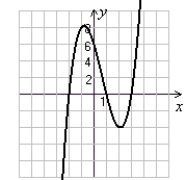
B)

C)
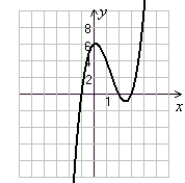
D)

A)

B)

C)

D)


فتح الحزمة
افتح القفل للوصول البطاقات البالغ عددها 122 في هذه المجموعة.
فتح الحزمة
k this deck
55
State the end behavior of the function. f(x) = -3x5 + 5x4 + x2 - 2x + 2
A) down/up
B) up/down
C) down/down
D) up/up
A) down/up
B) up/down
C) down/down
D) up/up

فتح الحزمة
افتح القفل للوصول البطاقات البالغ عددها 122 في هذه المجموعة.
فتح الحزمة
k this deck
56
State the end behavior and y-intercept of the function. Do not graph.
f(x) = -2x4 - 2x3 + x2 - 2x + 5
f(x) = -2x4 - 2x3 + x2 - 2x + 5

فتح الحزمة
افتح القفل للوصول البطاقات البالغ عددها 122 في هذه المجموعة.
فتح الحزمة
k this deck
57
Use the following to answer questions :
p(x) = x4 - 5x3 + 5x2 + 5x - 6
Apply Descartes's rule of signs to count the possible number of positive, negative, and complex roots (organize a table).
A)
B)
C)
D)
p(x) = x4 - 5x3 + 5x2 + 5x - 6
Apply Descartes's rule of signs to count the possible number of positive, negative, and complex roots (organize a table).
A)

B)

C)

D)


فتح الحزمة
افتح القفل للوصول البطاقات البالغ عددها 122 في هذه المجموعة.
فتح الحزمة
k this deck
58
Sketch the graph of the function using the degree, end behavior, x- and y-intercepts, zeroes of multiplicity, and a few midinterval points to round out the graph. Connect all points with a smooth, continuous curve.
f(x) = (x - 1)3(x + 2)(x + 3)
f(x) = (x - 1)3(x + 2)(x + 3)

فتح الحزمة
افتح القفل للوصول البطاقات البالغ عددها 122 في هذه المجموعة.
فتح الحزمة
k this deck
59
Use Descartes's rule of signs to determine the possible combinations of real and complex roots for the polynomial. Then graph the function on the standard window of a graphing calculator and adjust it as needed until you're certain all real roots are in clear view. Use this screen and a list of the possible rational zeroes (rational roots theorem) to factor the polynomial and find all zeroes (real and complex). p(x) = 20x3 - 153x2 - 62x + 48
A) p(x) = (x - 8)(2x + 1)(10x + 6)
B) p(x) = (x + 8)(10x - 1)(2x + 6)
C) p(x) = (x - 8)(5x - 2)(4x + 3)
D) p(x) = (x + 8)(4x + 1)(5x + 6)
A) p(x) = (x - 8)(2x + 1)(10x + 6)
B) p(x) = (x + 8)(10x - 1)(2x + 6)
C) p(x) = (x - 8)(5x - 2)(4x + 3)
D) p(x) = (x + 8)(4x + 1)(5x + 6)

فتح الحزمة
افتح القفل للوصول البطاقات البالغ عددها 122 في هذه المجموعة.
فتح الحزمة
k this deck
60
For the complex polynomial below, one of its zeroes is x = 3 - i. Use the given zero to help find all zeroes of the polynomial, then write the polynomial in completely factored form. Hint: synthetic division and the quadratic formula can be applied to all polynomials, even those with complex coefficients. C(x) = x3 - 3x2 + (3 + 3i)x + (-6 + 2i)
A) C(x) = (x - 3 - i)(x + 2i)(x + i); x = -2i, x = -i
B) C(x) = (x - 3 + i)(x - 2i)(x - i); x = 2i, x = i
C) C(x) = (x - 3 + i)(x + 2i)(x - i); x = -2i, x = i
D) C(x) = (x - 3 + i)(x - 2i)(x + i); x = 2i, x = -i
A) C(x) = (x - 3 - i)(x + 2i)(x + i); x = -2i, x = -i
B) C(x) = (x - 3 + i)(x - 2i)(x - i); x = 2i, x = i
C) C(x) = (x - 3 + i)(x + 2i)(x - i); x = -2i, x = i
D) C(x) = (x - 3 + i)(x - 2i)(x + i); x = 2i, x = -i

فتح الحزمة
افتح القفل للوصول البطاقات البالغ عددها 122 في هذه المجموعة.
فتح الحزمة
k this deck
61
Graph the polynomial function.
f(x) = x3 + 2x2 - 5x - 6
f(x) = x3 + 2x2 - 5x - 6

فتح الحزمة
افتح القفل للوصول البطاقات البالغ عددها 122 في هذه المجموعة.
فتح الحزمة
k this deck
62
Use the following to answer questions : 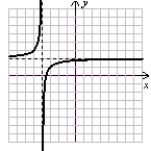 (Gridlines are spaced one unit apart.)
(Gridlines are spaced one unit apart.)
Give the equation related to the graph. Assume |a| = 1.
A)
B)
C)
D)
 (Gridlines are spaced one unit apart.)
(Gridlines are spaced one unit apart.)Give the equation related to the graph. Assume |a| = 1.
A)

B)

C)

D)


فتح الحزمة
افتح القفل للوصول البطاقات البالغ عددها 122 في هذه المجموعة.
فتح الحزمة
k this deck
63
Determine the location of the horizontal asymptote if it exists. Then determine whether the graph will cross the asymptote, and if so, where it crosses. 


فتح الحزمة
افتح القفل للوصول البطاقات البالغ عددها 122 في هذه المجموعة.
فتح الحزمة
k this deck
64
Use the following to answer questions : 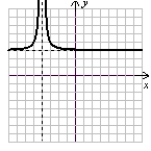 (Gridlines are spaced one unit apart.)
(Gridlines are spaced one unit apart.)
State the equations of the horizontal and vertical asymptotes.
A) y = 4, x = -3
B) y = -4, x = 3
C) y = -3, x = 4
D) y = 3, x = -4
 (Gridlines are spaced one unit apart.)
(Gridlines are spaced one unit apart.)State the equations of the horizontal and vertical asymptotes.
A) y = 4, x = -3
B) y = -4, x = 3
C) y = -3, x = 4
D) y = 3, x = -4

فتح الحزمة
افتح القفل للوصول البطاقات البالغ عددها 122 في هذه المجموعة.
فتح الحزمة
k this deck
65
Use the following to answer questions :  (Gridlines are spaced one unit apart.)
(Gridlines are spaced one unit apart.)
State the equations of the horizontal and vertical asymptotes.
A) y = -4, x = 2
B) y = 4, x = -2
C) y = 2, x = -4
D) y = -2, x = 4
 (Gridlines are spaced one unit apart.)
(Gridlines are spaced one unit apart.)State the equations of the horizontal and vertical asymptotes.
A) y = -4, x = 2
B) y = 4, x = -2
C) y = 2, x = -4
D) y = -2, x = 4

فتح الحزمة
افتح القفل للوصول البطاقات البالغ عددها 122 في هذه المجموعة.
فتح الحزمة
k this deck
66
Give the location of the vertical asymptote(s) if they exist, and state whether function values will change sign (positive to negative or negative to positive) from one side of the asymptote to the other. 
A) x = 1, no
B) x = 1, yes
C) x = -4, no; x = 1, no
D) x = -4, yes; x = 1, yes

A) x = 1, no
B) x = 1, yes
C) x = -4, no; x = 1, no
D) x = -4, yes; x = 1, yes

فتح الحزمة
افتح القفل للوصول البطاقات البالغ عددها 122 في هذه المجموعة.
فتح الحزمة
k this deck
67
Use the following to answer questions : 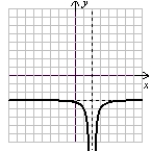 (Gridlines are spaced one unit apart.)
(Gridlines are spaced one unit apart.)
-State the range of the function.
A) y (-?, -2) (-2, ?)
B) y (-?, 2) (2, ?)
C) y (-?, -3)
D) y (-?, 3)
 (Gridlines are spaced one unit apart.)
(Gridlines are spaced one unit apart.)-State the range of the function.
A) y (-?, -2) (-2, ?)
B) y (-?, 2) (2, ?)
C) y (-?, -3)
D) y (-?, 3)

فتح الحزمة
افتح القفل للوصول البطاقات البالغ عددها 122 في هذه المجموعة.
فتح الحزمة
k this deck
68
Use polynomial division or synthetic division to rewrite the function, then sketch the graph using transformations of a parent function and the x- and y-intercepts (if they exist). 


فتح الحزمة
افتح القفل للوصول البطاقات البالغ عددها 122 في هذه المجموعة.
فتح الحزمة
k this deck
69
Graph the polynomial function.
f(x) = x4 + 3x3 - 3x2 - 11x - 6
f(x) = x4 + 3x3 - 3x2 - 11x - 6

فتح الحزمة
افتح القفل للوصول البطاقات البالغ عددها 122 في هذه المجموعة.
فتح الحزمة
k this deck
70
Use the following to answer questions :  (Gridlines are spaced one unit apart.)
(Gridlines are spaced one unit apart.)
Give the equation related to the graph. Assume |a| = 1.
A)
B)
C)
D)
 (Gridlines are spaced one unit apart.)
(Gridlines are spaced one unit apart.)Give the equation related to the graph. Assume |a| = 1.
A)

B)

C)

D)


فتح الحزمة
افتح القفل للوصول البطاقات البالغ عددها 122 في هذه المجموعة.
فتح الحزمة
k this deck
71
Use the following to answer questions : 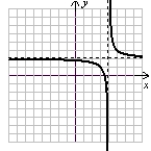 (Gridlines are spaced one unit apart.)
(Gridlines are spaced one unit apart.)
Use the direction/approach notation to describe the end behavior of the graph. (This should produce four statements.)
 (Gridlines are spaced one unit apart.)
(Gridlines are spaced one unit apart.)Use the direction/approach notation to describe the end behavior of the graph. (This should produce four statements.)

فتح الحزمة
افتح القفل للوصول البطاقات البالغ عددها 122 في هذه المجموعة.
فتح الحزمة
k this deck
72
Determine the location of the horizontal asymptote if it exists. Then determine whether the graph will cross the asymptote, and if so, where it crosses. 
A) y = 0; crosses at (1, 0)
B) y = 0; does not cross
C) y = 2; does not cross
D) No horizontal asymptote

A) y = 0; crosses at (1, 0)
B) y = 0; does not cross
C) y = 2; does not cross
D) No horizontal asymptote

فتح الحزمة
افتح القفل للوصول البطاقات البالغ عددها 122 في هذه المجموعة.
فتح الحزمة
k this deck
73
Use the following to answer questions :  (Gridlines are spaced one unit apart.)
(Gridlines are spaced one unit apart.)
-State the domain of the function.
A) x (-?, -2) (-2, ?)
B) x (-?, 2) (2, ?)
C) x (-?, -3) (-3, ?)
D) x (-?, 3) (3, ?)
 (Gridlines are spaced one unit apart.)
(Gridlines are spaced one unit apart.)-State the domain of the function.
A) x (-?, -2) (-2, ?)
B) x (-?, 2) (2, ?)
C) x (-?, -3) (-3, ?)
D) x (-?, 3) (3, ?)

فتح الحزمة
افتح القفل للوصول البطاقات البالغ عددها 122 في هذه المجموعة.
فتح الحزمة
k this deck
74
Give the location of the vertical asymptote(s) if they exist, and state the function's domain in set notation. 
A) x = 1; {x | x R, x ? 1}
B) x = -3; {x | x R, x ? -3}
C) x = 4; {x | x R, x ? 4}
D) No vertical asymptote; {x | x R}

A) x = 1; {x | x R, x ? 1}
B) x = -3; {x | x R, x ? -3}
C) x = 4; {x | x R, x ? 4}
D) No vertical asymptote; {x | x R}

فتح الحزمة
افتح القفل للوصول البطاقات البالغ عددها 122 في هذه المجموعة.
فتح الحزمة
k this deck
75
Give the location of the vertical asymptote(s) if they exist, and state whether function values will change sign (positive to negative or negative to positive) from one side of the asymptote to the other. 
A) x = 4, no
B) x = 4, yes
C) x = -1, no; x = 2, no
D) x = -1, yes; x = 2, yes

A) x = 4, no
B) x = 4, yes
C) x = -1, no; x = 2, no
D) x = -1, yes; x = 2, yes

فتح الحزمة
افتح القفل للوصول البطاقات البالغ عددها 122 في هذه المجموعة.
فتح الحزمة
k this deck
76
Use the following to answer questions :  (Gridlines are spaced one unit apart.)
(Gridlines are spaced one unit apart.)
Use the direction/approach notation to describe the end behavior of the graph. (This should produce four statements.)
 (Gridlines are spaced one unit apart.)
(Gridlines are spaced one unit apart.)Use the direction/approach notation to describe the end behavior of the graph. (This should produce four statements.)

فتح الحزمة
افتح القفل للوصول البطاقات البالغ عددها 122 في هذه المجموعة.
فتح الحزمة
k this deck
77
Determine the location of the x- and y-intercepts (if they exist), and state the behavior of the function (bounce or cut) at each x-intercept. 
A) (0, 0), bounce; (-2, 0), cut
B) (0, 0), cut; (-2, 0), bounce
C) (0, 0), bounce; (-2, 0), cut; (5, 0), bounce
D) (0, 0), cut; (-2, 0), bounce; (5, 0), cut

A) (0, 0), bounce; (-2, 0), cut
B) (0, 0), cut; (-2, 0), bounce
C) (0, 0), bounce; (-2, 0), cut; (5, 0), bounce
D) (0, 0), cut; (-2, 0), bounce; (5, 0), cut

فتح الحزمة
افتح القفل للوصول البطاقات البالغ عددها 122 في هذه المجموعة.
فتح الحزمة
k this deck
78
Use the following to answer questions :  (Gridlines are spaced one unit apart.)
(Gridlines are spaced one unit apart.)
-State the domain of the function.
A) x (-?, -4) (-4, ?)
B) x (-?, 4) (4, ?)
C) x (-?, -2) (-2, ?)
D) x (-?, 2) (2, ?)
 (Gridlines are spaced one unit apart.)
(Gridlines are spaced one unit apart.)-State the domain of the function.
A) x (-?, -4) (-4, ?)
B) x (-?, 4) (4, ?)
C) x (-?, -2) (-2, ?)
D) x (-?, 2) (2, ?)

فتح الحزمة
افتح القفل للوصول البطاقات البالغ عددها 122 في هذه المجموعة.
فتح الحزمة
k this deck
79
Give the location of the vertical asymptote(s) if they exist, and state the function's domain in set notation. 
A) x = 2; {x | x R, x ? 2}
B) x = ; {x | x R, x ?
; {x | x R, x ?
 }
}
C) x = -5, x = -1; {x | x R, x ? -5, x ? -1}
D) No vertical asymptote; {x | x R}

A) x = 2; {x | x R, x ? 2}
B) x =
 ; {x | x R, x ?
; {x | x R, x ? }
}C) x = -5, x = -1; {x | x R, x ? -5, x ? -1}
D) No vertical asymptote; {x | x R}

فتح الحزمة
افتح القفل للوصول البطاقات البالغ عددها 122 في هذه المجموعة.
فتح الحزمة
k this deck
80
Use the following to answer questions :  (Gridlines are spaced one unit apart.)
(Gridlines are spaced one unit apart.)
-State the range of the function.
A) y (-?, -4) (-4, ?)
B) y (-?, 4) (4, ?)
C) y (-?, -2) (-2, ?)
D) y (-?, 2) (2, ?)
 (Gridlines are spaced one unit apart.)
(Gridlines are spaced one unit apart.)-State the range of the function.
A) y (-?, -4) (-4, ?)
B) y (-?, 4) (4, ?)
C) y (-?, -2) (-2, ?)
D) y (-?, 2) (2, ?)

فتح الحزمة
افتح القفل للوصول البطاقات البالغ عددها 122 في هذه المجموعة.
فتح الحزمة
k this deck








